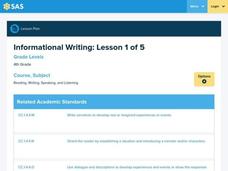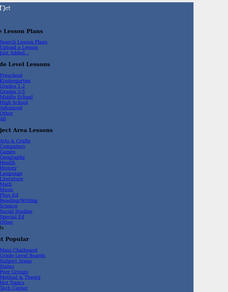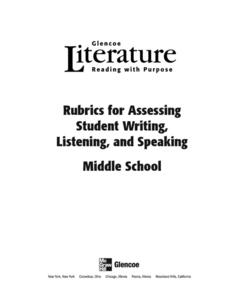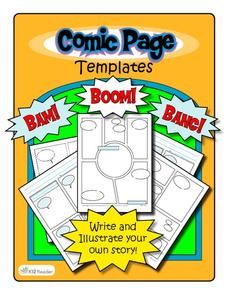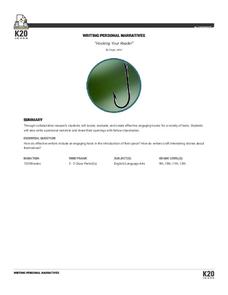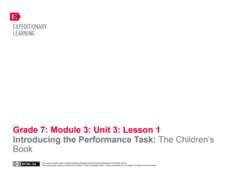Curated OER
Writing Morning: Narrative Setting
Provide an overview of setting in a narrative. Learners discuss story elements, focusing on setting. Then, they set the scene for an imaginary world using their five senses. This is a great way to help your class better understand this...
Curated OER
Storytelling: Writers' Workshop Learning Center
Evaluating a variety of narrative texts can help build strong writers. Pupils identify plot elements and their relation to personal experience, then apply what they gleaned from the class discussion to create their own narratives.
Curated OER
Like Water for Chocolate: Family Tradition
Engage young writers in family tradition with this writing assignment for Like Water for Chocolate, by Laura Esquivel. Using sensory details, learners write a narrative about a family tradition involving food. Scholars also talk with...
Curated OER
In Search Of Wisdom: An Interview With An Elder
The key to writing a good narrative is having good material to work with; and the key to getting good material is asking good questions. Working in groups, class members brainstorm questions that might result in the most interesting...
Pennsylvania Department of Education
Informational Writing
Emerging writers identify an informational piece of writing. They are provided with examples of informational writing and view a PowerPoint on narrative writing. Then, they design their own informational writing with a brochure,...
Curated OER
Change of Perspective
After reading an example of a Cultural Connection about a particular person, class members are asked to think about what this person might experience on a daily basis. They then craft a narrative from the subject’s point of view.
Curated OER
Using Graphology to Teach Traditional Writing
Introduce your class to the narrative, descriptive and expository forms of writing. In groups, they discuss the personality of the author while graphing the characteristics after reading different examples from the same writer. To end...
Curated OER
Remembering Waiting
After a close study of the pastel drawing Waiting by Edgar Degas have the class imagine the story Degas may be telling through the body language and clothing of the people in the work of art. Your young writers then create a drawing...
Curated OER
Build a Tasty Sandwich
The subject doesn't sound to interesting, but with a child's imagination even a trip to the store can be an adventure. The class writes a narrative story about a trip to the store. They organize their stories to include an introductory...
Curated OER
Facing the Ghosts of Our Past
A reading of a New York Times review of the movie Beloved launches research into how the Civil War affected the lives of people living during this period. Creative thinkers select a person from an included list of historical figures and...
Curated OER
Lesson: Storyboarding Revolution
Kids consider revolution as a basis for creativity, art, and storytelling. After reading an excerpt from the book, Persepolis, learners choose one event from any world revolution to write about. They storyboard the event focusing on...
Curated OER
Narrative Writing Lesson
Sixth graders experience the stages of process writing, work cooperatively, to critique and to incorporate software tools to enhance writing and problem solving skills.
Curated OER
Rubrics for Assessing Student Writing, Listening, and Speaking Middle School
This is a fantastic collection of a wide variety of rubrics for writing, listening, and speaking! The resource contains over 14 rubrics for assessing such items as a summary, autobiographical sketch and narrative, speech, oral report,...
K12 Reader
Comic Page Templates
Looking for a set of comic strip templates? Use a resource with five comic templates complete with writing frames and text bubbles. Not only is it a great tool to have on hand in the classroom, but especially when working on narrative...
Fluence Learning
Writing a Narrative: Two Frogs
Three options offer young writers the opportunity to read a short story, answer questions, and write a response. A handy language arts resource focuses on reading comprehension and analyziing the story's lesson: look before you leap.
K12 Reader
Lost and Found
You're walking down the street and find a wallet on the ground. What do you do with it? This age-old scenario serves as a narrative writing prompt that challenges children to come up with creative stories describing the fate of the lost...
EngageNY
Peer Critique for Organization and Style
Put another set of eyes on your class's historical fiction narratives with one of the final lessons in the unit. Fourth graders use feedback from their peers to annotate their drafts for revision, particularly their bold beginnings and...
EngageNY
Reviewing Conventions and Editing Peers’ Work
Encourage young writers to edit text based on conventions. After reviewing the conventions, fourth graders watch a teacher demonstrate how to revise a paragraph for correct spelling, capitalization, punctuation, or dialogue. Then, pairs...
K20 LEARN
Hooking Your Reader
Hook your class into inquiry-based, hands-on learning with a activity on narrative leads. Pupils research different types of hooks and decide which one to use in their own writing. Carefully scaffolded to include all learners, the...
EngageNY
Introducing the Performance Task: The Children’s Book
Using a Venn diagram, class members generate similarities and differences between narratives and summaries. Next, pupils co-create an anchor chart to capture their thinking about how an author zooms in on a particular part of a story.
Facing History and Ourselves
Becoming Ourselves
Here's a great way to build community during the first days of the new school year. Participants read personal narratives, then craft and share their stories with others.
K20 LEARN
The Anatomy Of A Story: Story Structure
Somebody. Wanted. But. Then. Introduce your classes to the structure that supports stories with a instructional activity that teaches readers how to identify the four basic components writers use to craft their tales. After identifying...
Scholastic
Active Beginnings
Help your pupils build narratives and stories that capture the attention of their readers with this set of worksheets. The first focuses on active introductory sentences, the second on exciting transition words and phrases, and the third...
Teach-nology
Author’s Purpose: Entertain
How does an author entertain his or her audience? Read a short fairy tale and find the most evocative passages to discover more about author's purpose in narrative writing.
Other popular searches
- Narrative Writing
- Narrative Writing Prompts
- Narrative Writing Ideas
- Narrative Paragraph
- Narrative Elements
- Personal Narrative Writing
- Personal Narratives
- Narrative Writing Grade 3
- Narrative Writing Worksheets
- Narrative Poetry
- Narrative Essays
- Fictional Narrative






